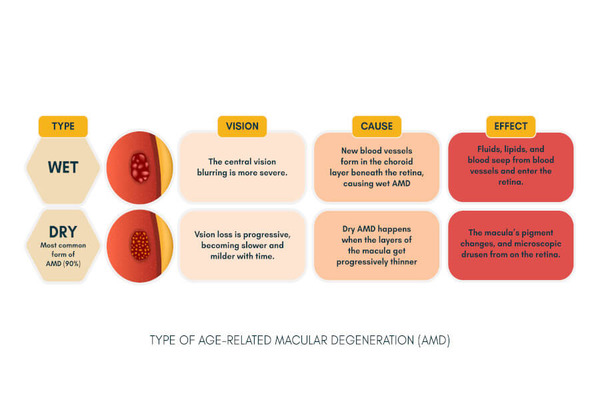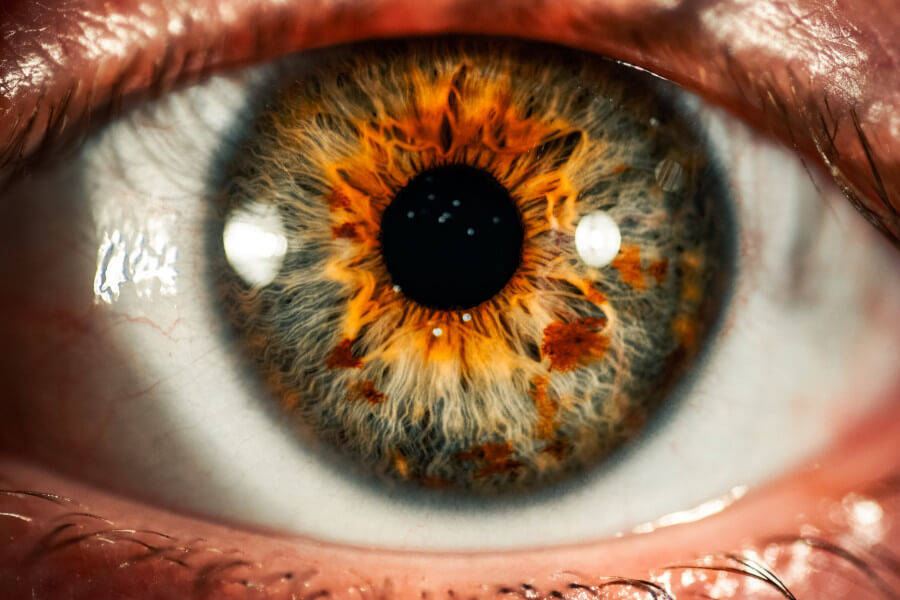Health Conditions
Understanding Age-Related Macular Degeneration
What is age related macular degeneration (AMD)?
Age related macular degeneration (AMD) is a problem with the retina of your eye. It occurs when the macula, a portion of the retina is impaired. The retina is the back of your eye’s light-sensing nerve tissue. Age-related macular degeneration is the name given to the disease since it occurs as people age. It seldom results in blindness, but it can cause serious vision complications.
What are the types of age related macular degeneration?

What are the risk factors?
AMD primarily affects adults over the age of 60. Age, family history of AMD, and smoking are all key risk factors for AMD. Polypoidal Choroidal Vasculopathy (PCV) is a kind of AMD that primarily affects Asian people. There are usually no indications of dry AMD in either eye in PCV, and the patient can have rapid vision loss due to macular bleeding.
What are the symptoms of age related macular degeneration?
You may not notice any symptoms of macular degeneration at first. It is possible that it won’t be diagnosed until it worsens or affects both eyes.
- Visual field obstruction: The “visual field” refers to the vast range of vision that a healthy eye can see. The centre of a person’s visual field may become blurred, distorted, or lost as AMD develops. Reading, driving, watching TV, and recognizing faces will all be affected.
- Contrast sensitivity: Textures and small changes in the environment become more difficult to notice. It can be risky and lead to an increased risk of falling if you lose your ability to perceive tiny contrasts and textures in pavements or steps. When two colours of similar hues are placed side by side, it may be difficult to tell them apart.
- Intolerance to changes in light intensity: When driving or strolling after sunset, or when changing from a brightly lit room to a less lit one, your eyes may find it difficult to adjust. The condition can be aggravated by glare. A bright shaft of sunshine streaming in through a window, for example, may “blackout” everything outside the glare.
- For reading, cooking, and other day-to-day tasks, you may discover that brighter lights are required.
- Walking becomes more difficult when you can’t gauge distances correctly, which might lead to missteps and falls.
How is age-related macular degeneration diagnosed?
Because AMD rarely causes symptoms in its early stages, annual eye exams are critical for recognizing the disease and initiating therapies at the most beneficial time. During an eye exam, your eye doctor examines the retina and macula for changes. One or more of the following tests may be administered to you:
Amsler grid test:
An Amsler grid consists of straight lines with a huge central dot. Your healthcare professional may ask you to identify grid lines or parts that are fuzzy, wavy, or broken. If you notice a lot of distortion, it could be a sign that you have AMD or that the condition is progressing. This visual field test can be used at home to keep track of your eyesight.
Fluorescein angiography:
Fluorescein dye is injected into a vein in the arm or hand. The images are captured sequentially using a camera on a table (the person sits in front of it). The images demonstrate aneurysmal-like choroidal and retinal leakage (wet AMD). This imaging approach takes 20 minutes overall and involves dilation drops. After the body metabolizes the dye, urine and saliva may be orange.
Optical coherence tomography (OCT):
This method uses infrared light waves to take cross-sectional pictures of the retina and choroid layer. OCT gives useful information concerning drusen, retinal anatomy, new blood vessels, and haemorrhages. The subject sits in front of the camera with their chin placed on a chin rest after dilation drops. Imaging equipment requires 15 minutes.
Genetic Testing:
Genetic testing, which is now available for Stargardt disease and other juvenile macular degeneration illnesses, offers another diagnostic option for young-onset macular degeneration. Stargardt disease is caused by a recessive gene, which can be detected by genetic testing. Currently, Stargardt genetic testing has two main purposes: the first is for family planning, and the second is to identify Stargardt in young people who have developed symptoms of the condition. However, scientists are focusing their efforts on the human genome, the coding that instructs the body on how to construct and repair itself. They anticipate that in the next few years, gene therapy will allow them to replace damaged genes in a person’s DNA who has Stargardt or AMD. This research is supported by the American Macular Degeneration Foundation.
Treatment and Management of AMD
AMD can’t be cured. Early treatment can help to decrease the progression of the disease and lessen the severity of the symptoms. Even after effective therapy, symptoms of AMD frequently recur. There is no cure for dry AMD, however, visual aids can help you live a better life. The treatment goal for wet AMD is to keep your vision from deteriorating, you may need regular eye injections and, in rare cases, a light treatment called photodynamic therapy. Some treatments include:
- Supplements: A combination of vitamins and minerals may reduce the growth of dry AMD, according to the Age-Related Eye Disease Study (AREDS). Vitamin C, vitamin E, lutein, zinc, copper, zeaxanthin, and beta carotene are among the AREDS supplements.
- Anti-vascular endothelial growth factor (anti-VEGF): This wet AMD treatment inhibits the synthesis of VEGF, a protein that promotes the formation of new blood vessels. Anti-VEGF is injected into a numbed eye by your ophthalmologist. Blood vessel growth is either slowed or stopped by the drug. This treatment may help you see better.
- Photodynamic therapy (PDT): Your eye healthcare practitioner will use a combination of an injectable light-sensitive medication and a laser to remove excess blood vessels in the eye during photodynamic therapy. PDT and anti-VEGF may be used together by your doctor.
Learn more about how our DNA test can help you. It’s considered the most advanced DNA test in Malaysia that we can provide, so we’d like to offer you our premium DNA test. You can take advantage of this offer and reap the benefits of getting a DNA test.


